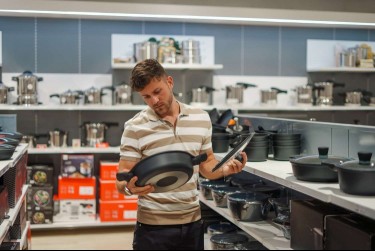- How a piece of cookware is coated may impact how healthy (or safe) it is to use.
- In general, glass or stainless steel cookware options are the healthiest, as they do not have a coating on them.
- Experts recommend prioritizing keeping your cookware, no matter what kind you have, in good condition by avoiding high heat, using soft sponges to clean, and not scraping pots and pans with any metal utensils.
Some cookware options may be healthier to use than others.
There is no shortage of cookware variety. Stainless steel, glass, Teflon, cast iron, copper—the list goes on.
With all these options, it can be tricky to know which is the best choice.
Which has the highest quality material? Is there one that’s known to be the best nonstick skillet? Most importantly, which type of cookware is safest to cook with?
While you’re shopping, you’ll come across these two main types of cookware: ceramic and PTFE (more commonly known by its brand name, Teflon).
PTFE is best known for its nonstick quality. However, there have been concerns about the chemicals used in PTFE coating and its long-term health implications.
Previous studies showed the chemical perfluorooctanoic acid (PFOA) used to make Teflon was associated with cancer. This harmful chemical has since been banned.
Ceramic cookware, on the other hand, is made of a sand derivative, which results in a slick, nonstick finish.
Here’s what to consider when choosing the cookware that is healthiest for you and your family.

Getty Images / Igor-Kardasov
Choosing the Healthiest Cookware
When choosing a piece of cookware for your home, it’s important to consider what is safest for long-term use.
“For the most part, you should try to purchase safe cookware for your home where the hope is that you do the majority of the cooking,” Julia Zumpano, a registered dietitian with the Cleveland Clinic Digestive Disease Institute, told Health.
And, technically, the “healthiest” choices in cookware are neither ceramic nor Teflon, but glass and stainless steel.
“If you are able to use or purchase glass or Pyrex, stainless steel pots and pans, they are healthier choices for long-term/lifetime use,” Jim Perko, Executive Chef in the Center for Integrative & Lifestyle Medicine at the Cleveland Clinic, told Health.
This comes down to how cookware is coated.
There are several factors to take into consideration, including the type of underlying metal, the coating, and how it’s applied.
In most cases, ceramic cookware is made out of metal and coated with a nonstick material (typically silicon). This is safer, relatively speaking, at higher temps, but some brands may use a coating that contains heavy metals.
The chemical in original Teflon products has been banned since 2014 (PFOA), Zumpano explained. Newer Teflon products use PFAs, though research links these chemicals to health concerns as well.
“Because there are many different brands of ceramic and Teflon, the actual type of coatings and how the coatings are applied, and the type of metals the actual pan is made from, there are many variables of the longevity and associated safety,” Perko explained.
Because both ceramic and Teflon products contain a coating—glass and stainless steel do not. That makes the latter a safer, healthier choice.
Ceramic vs. Teflon Sustainability
In general, the sustainability of both ceramic and Teflon cookware depends on how it’s cleaned. Perko recommends the following for keeping your cookware in good condition:
- Avoid high heat while cooking
- Avoid searing
- Wash with a sponge
- Avoid scrubbing with anything abrasive
- Avoid using metal tongs, spatulas, or utensils on the cookware
Cookware Safety Tips to Keep in Mind
In addition to being aware of any coating that may be on your cookware, it’s also important to know the base material. Over time, the coating can disintegrate, and the material underneath could enter your food.
“Limit chemicals such as PFOA, PFAS, and nonstick varieties,” Zumpano said. “If you choose metal-based cookware, avoid aluminum unless anodized aluminum, [because aluminum] can seep into your foods, cast iron and stainless steel are generally considered safe, [use] caution with copper.” Anodized aluminum doesn’t react with acidic foods, so it doesn’t leach aluminum into your meal.
Also, whenever possible, avoid cooking with high heat, especially if you’re cooking animal proteins, Perko explained.
But, if you’re really concerned about your cookware, prioritize the top options.
“Glass, like Pyrex cookware, is a safe option,” Perko said. “Cast iron is a safe option if NOT frying or using high-temperature cooking. If you have or can use or purchase stainless steel pots and pans, they are healthier choices for long-term/lifetime use.”
The bottom line? Rather than choosing between ceramic and Teflon cookware based on their coatings, focus on the base material. In other words, fill that shopping cart with glass, Pyrex, and stainless steel cookware.
9 Household Items That Need to Be Replaced Regularly







